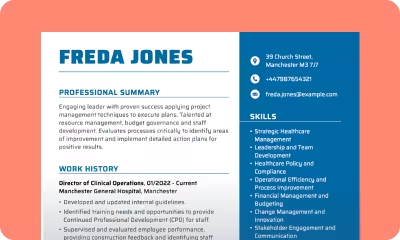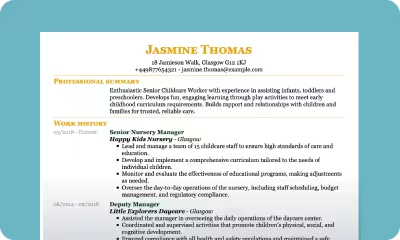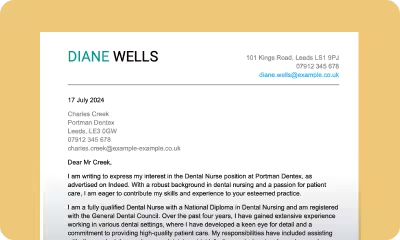How to write work experience on your CV
Writing about your work experience is the flesh on the bones of your CV. Whatever role you’re applying for, sector you work in, or level of experience you have, it’s a vital part of your CV which will get the most attention from recruiters. Thankfully, it doesn’t take long to master the right content, structure, and writing style.

Our customers have been hired by: *Foot Note
Roughly translated from Latin, curriculum vitae (CV) means the “course of one’s life”. As such, it’s not hard to see why work experience is so important in this document. It’s all well and good listing the educational achievements and skills that you’ve acquired over the course of your life – but recruiters really want to see the years you’ve spent putting them into practice and developing them.
The problem? While lots of people have a wealth of working experience, few are experienced in how to write a CV. Unfortunately, that means some of the best experience is overlooked due to the way it’s presented. Not for you though.
We’ve put together a comprehensive guide to CV work experience with plenty of examples, covering everything from the structure and what to include, to some basic rules for writing about your experience. With our help, you’ll be able to showcase your best work experience and secure that all-important interview.
What experience to include on your CV
First things first, let’s be clear about what recruiters are looking for in your CV’s work experience section.
The most important factors are recency and relevance. You should include your most recent experience that’s relevant to the job at hand.
In an ideal world, you’ll currently be working in a role similar to the job you’re applying for. That would be both recent and relevant, making it obvious to include. Then your CV could look like this:
But let’s say you’re not…
Recent experience that doesn’t seem relevant
If you’re applying for a role as a graphic designer, should you include your last job as a barista? The answer is yes – because it’s recent, and in many ways relevant too.
Most jobs demonstrate transferable (soft) skills, such as teamwork, communication, and time management, which are still valuable to employers. They can complement other parts of your CV like skills and education. That could be anything from a formal full-time position to a part-time job, volunteering role, or internship.
Relevant experience that’s not so recent
On the flipside, you might have experience that’s really relevant but not particularly recent. If you’ve had a career break to raise your children after working as a supply chain manager, for example, then several years may have passed. So, should you include it?
The answer depends on what you’ve done in the meantime. If you’ve had several jobs since your most relevant experience, it’s probably best to focus on those to avoid your CV becoming too long. You can always mention your more distant career history in your cover letter. However, if that job is still within your most recent experience, then go ahead and put it on your CV.
So, what shouldn’t I include?
The only experience you shouldn’t include on your CV is any job which would make your work experience section longer without adding anything important.
We generally recommend including the last 3-5 jobs you’ve had within the past 10-15 years of your career. If you find yourself going further back than that, it’s worth reining it in a little. Recruiters are busy people with lots of CVs to get through, so they’ll appreciate your efforts to keep things concise.
How to structure your work experience
Once you’ve figured out what to include, the next challenge is structuring it properly. This has two main elements – the order of the jobs and what you should write about each job.
How to order your jobs
This one is simple. Your jobs should be written in reverse-chronological order, starting with the most recent. This allows recruiters to see your most recent (and often most relevant) experience, then work backwards.
You might think that a particular job warrants a higher position on your CV. However, that could confuse things, making it harder for readers to make sense of your career progression.
A potential employer might only read the first role and assume that you haven’t been working for several years. Alternatively, they may even think that you’re trying to cover up career gaps if your experience doesn’t follow a reverse-chronological pattern.
Listing your jobs
Now it’s onto the jobs themselves. Start with the basic details:
- Position or job title
- Start date and end date (use ‘current’ or ‘present’ for a job you’re still in)
- Employer
- Location – just the town or city will suffice
Next, you need to summarise what you did in that role. This is where many people slip up a bit, by writing a block of text like the following:
In my time at T&B Manufacturing, I oversaw the production of various car parts by managing a team of over 20 staff. We continually hit KPIs for production, which were monitored using Sage MRP software.
Instead, use bullet points with concise sentences, like this:
- Oversaw the manufacturing of various car parts
- Managed a team of 20+ staff
- Monitored production using Sage MRP
- Continually hit KPIs
Of course, this is just one small step. There’s a lot more that can be done to improve the duties and responsibilities on your CV, which we’ll discuss below…
5 rules for writing about your work experience
First person is a no-go
On a document that’s entirely about you, the first person (I, me, my) might seem like an obvious choice. However, it’s quite the opposite. Because you’re talking about yourself so much, using words like “I”, “me”, and “my” can become incredibly repetitive. While it is about you, your CV should focus on what you can offer to a potential employer.
As such, it’s much better to use the third person or omit the subject from your duties and responsibilities. For example:
- Worked with a team of 5 accountants
- Prepared monthly financial reports
- Handled invoices, tax returns, and expenses claims
Simply removing “I” from the start of these duties makes them less repetitive and shifts the focus from you to the duties themselves.
Focus on you, not the company
A common mistake with CV work experience is to introduce the company you worked for, rather than the job you did. For example:
Sales Assistant | ABC Textiles, Birmignham | June 2022 – Present
ABC textiles produces a wide range of home furnishings for the wholesale market, distribution throughout the UK and further afield. Orders are typically upwards of £10,000.
Remember, recruiters are looking to hire you – not the companies you’ve worked for. If you want to show that the company is similar to the one you’re applying to, you can do so in your own duties, such as:
Sales Assistant | ABC Textiles, Birmignham | June 2022 – Present
- Managed sales of a wide range of home furnishings for the wholesale market
- Organised distribution throughout the UK and further afield
- Regularly dealt with orders worth over £10,000
Like here:
Fabricator Welder
- Measured component pieces and checked values against task specifications.
- Fabricated component pieces and built structures from start to finished product.
- Safely operated heavy machinery to perform operations to highest standards.
Quantify your work experience
There’s nothing more powerful than numbers for your CV. They quantify your work experience to show employers exactly what you’re capable of – giving them a clearer picture of what you could do for them.
Ideally, you want to give them an idea of the scale of tasks you handled, such as:
Managed a digital marketing budget of £55,000 per month
Increased footfall by 35% year on year
However, specifics aren’t always easy to come by, and numbers can vary from day to day or month to month in lots of jobs. If you’re unsure, it’s best to include a broader range:
Served 50+ restaurant customers per day
Made approximately 80-100 sales in store.
Still racking your brain for numbers? Remember that frequency is another way to get specific about your work experience:
Performed a comprehensive safety inspection twice a week
Completed daily stock takes to monitor inventory levels
Tailor your experience to the job at hand
No two jobs are the same. But that doesn’t mean your experience isn’t useful to the job you’re applying for. It’s simply a case of cross-referencing the two and finding the best match:
- Look through the job description and pick out the key responsibilities of the role
- Consider whether any of your experience reflects those responsibilities
- Use CV experience examples that are the best fit for the job at hand
- Do this for every job you apply for to give your CV the edge
Variety is the spice of life!
Finally, you want to include as many different responsibilities as you can. This will present you as a well-rounded candidate, rather than a one-trick pony. The best advice here is to list different responsibilities for each job, removing any overlap and repetition.
If you have had three roles as a teacher, for example, don’t list lesson planning on all three. While you will have undoubtedly done it at every school, you’ve already ticked that box on your CV. Other jobs could focus on helping underperforming pupils, planning extracurricular activities, or achieving a certain pass rate for your students.
Where to put work experience on your CV
Work experience will form the main body of most CVs, given how much there is to talk about. Even if you’ve had just one job in the past, it provides more selling points than most standalone qualifications.
Because of this, it makes sense to include your work experience after your contact details and personal statement – which should be at the top of every CV. This can then be followed by skills, education, and any additional sections like interests or achievements.
This is the case for the vast majority of CVs. However, if you have very little experience and feel that your technical and transferable skills should take centre stage, a skills-based CV might be a better fit. In this case, your work experience should be placed further down your CV – after an expanded CV skills section and potentially after your education too, if that is important for the job in question.
How long should your CV’s work experience section be?
One of the most commonly asked questions about work experience on a CV concerns the length. You don’t want your experience to be too short, as it might look like you’re inexperienced. On the other hand, you don’t want to bore recruiters with a work history section that’s far too long.
In truth, there’s no one-size-fits-all length for your CV work experience. Candidates who have had more jobs will naturally fill up more space with their duties and achievements. However, here are some general rules of thumb to bear in mind:
- It’s seldom necessary to list more than 5 jobs or go further than 15 years into your career history
- List 3-6 duties per job, with additional duties for more recent roles
- Duties should be no more than one sentence
- Your CV as a whole should be no longer than two pages – and two pages is only recommended for mid-career applicants with 10+ years’ experience
How to write about work experience on a CV

After reading through all the advice and CV examples above, it’s time to start writing your CV work experience.
STEP 1
Review your employment history
The first step is to pull together all the information you can about your previous jobs. That includes basic details like start and end dates, along with all responsibilities and achievements. You can do this in your own words – all that matters is getting it all out there. Don’t worry about duplication for now, you can narrow things down later.
Note: Save this as the starting point for any other CVs you need to write!
STEP 2
Choose what’s relevant to the job
Next, read through the job description or listing for the role you want and decide which parts of your experience are most relevant. You don’t have to tick every box in every previous position. It’s about the bigger picture.
STEP 3
Write and format
Finally, put pen to paper (or fingers to the keyboard) and write the most relevant responsibilities and achievements in a concise manner. That includes reverse-chronological order, bullet points, and avoiding first person words like “I” and “my”.
Takeaways for your CV work experience
Putting work experience on a CV doesn’t have to be difficult. Above all else, it’s about making the experience you do have relatable to the job you’re applying for. That should be done in a concise manner with bullet-point responsibilities for each job, which highlight the full breadth of your relevant experience.
Need more inspiration? You can see lots more work experience on CV examples from a wide range of sectors on our site. Or get started with our quick and easy CV builder.
Jagoda Jaskowicz
Senior Content Editor, SEO Content Writer
Meet Jagoda Jaskowicz – a certified copywriter, Polish language translator, and seasoned career adviser. Thriving on constant self-improvement, she eagerly stays ahead in her field. With a rich background working with individuals from over 50 countries, Jagoda has successfully completed more than a thousand projects in copywriting and translation.
*The names and logos of the companies referred to above are all trademarks of their respective holders. Unless specifically stated otherwise, such references are not intended to imply any affiliation or association with myperfectCV.










